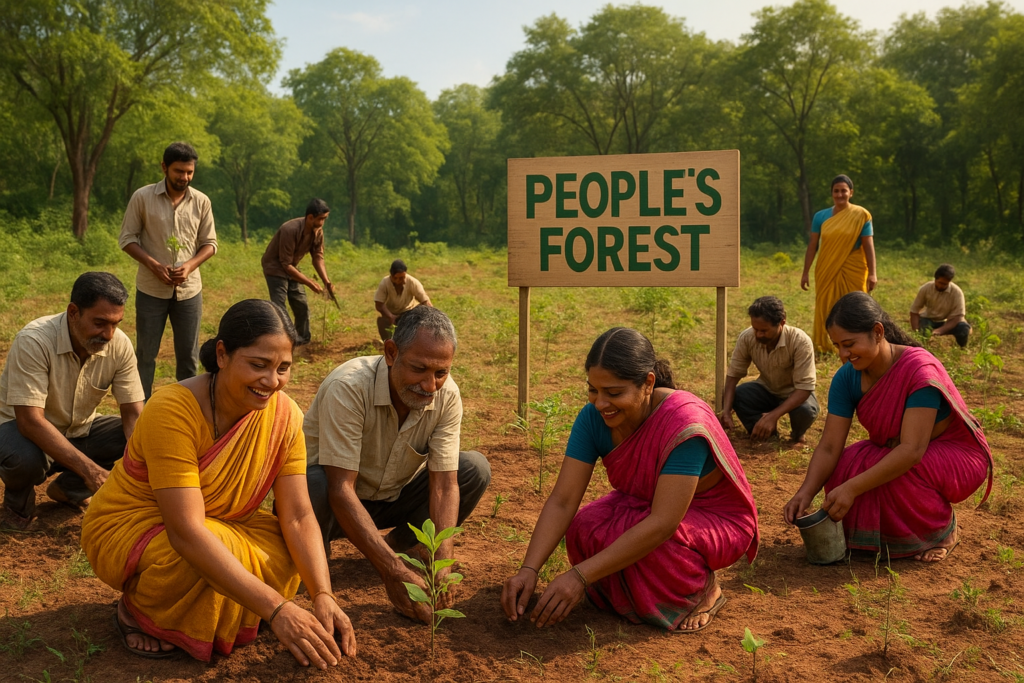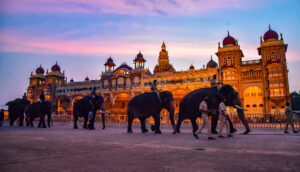On a blistering summer afternoon in Karnataka’s Uttara Kannada district, where temperatures have been rising every year, a quiet revolution has been unfolding. Tired of waiting for outside help, the residents of a small village called Halemane decided to take matters into their own hands. What began as a few farmers planting saplings on barren land has now turned into a community-led movement that has captured attention across India.
Today, locals proudly call it the “People’s Forest”—a 40-acre stretch of once-barren land now dense with trees, alive with birdsong, and cooler than the concrete towns around it.
The Beginning: From Complaint to Action
“It started with a complaint,” recalls 62-year-old farmer Raghunath Hegde. “We were angry that our wells were drying up every summer, and we thought the government should do something. But then one of the young men in our village said—why don’t we do it ourselves?”
That spark led to a village meeting under a banyan tree. Instead of arguing over water shortages, they discussed solutions. The elders brought knowledge of traditional farming, while the younger generation searched YouTube videos on afforestation and water conservation.
Within weeks, 200 families pooled their resources—not money, but time, labor, and determination.
Planting Hope, One Sapling at a Time
The villagers began with just 500 saplings of native species: jackfruit, mango, teak, honge, and neem. With no budget for professional equipment, they dug pits with hand tools. The women formed watering teams, carrying pots from nearby wells. Children collected seeds during walks.
“It was hard in the beginning,” says Meera Naik, a 28-year-old teacher. “The first year, many saplings died because of heat and grazing animals. Some people wanted to give up. But others said—if we stop now, we lose everything.”
Instead of quitting, they built bamboo fences, dug small check-dams to store rainwater, and learned about mulching to keep soil moist. Slowly, survival rates improved.
A Forest Takes Root
Seven years later, what was once rocky ground is unrecognizable. The canopy is thick enough to shade the soil. Birds like hornbills and drongos have returned. Monkeys swing between branches, and locals say they’ve even spotted porcupines.
But the biggest change is water. The village’s wells, which used to run dry by April, now hold water until June. Streams that had vanished reappeared during the monsoon.
“It feels like nature is giving back what we gave to it,” says Lakshmi Bai, an elderly villager who now walks her grandchildren through the forest every evening.
The Ripple Effect
The Halemane story didn’t stay hidden for long. A local NGO documented the project and shared it online. Soon, photos of villagers planting trees with bare hands went viral. The state forest department visited, followed by journalists, and then volunteers from nearby towns.
Now, the “People’s Forest” has become a model. More than 20 nearby villages have started their own planting drives. College students spend weekends volunteering there. Even tech workers from Bengaluru have begun sponsoring saplings.
The Bigger Picture: Climate Change Meets Local Wisdom
India has pledged to increase its green cover to fight climate change, but massive government plantations often fail due to lack of care. Experts say the Halemane model works because it’s community-owned.
“When people plant their own trees, they protect them like family,” explains Prof. Yogendra Kambalagere, an environmental scientist from Kuvempu University who has studied the project. “This isn’t just about trees. It’s about reclaiming control over water, climate, and life.”
Struggles and Sacrifices
The road hasn’t been easy. Villagers sacrificed income by giving land for planting. Young men who could have migrated to cities for jobs stayed back to build check-dams. There were even disputes over grazing rights that had to be resolved by the panchayat.
But each struggle made the community stronger. “We realized that unity is our real strength,” says farmer Raghunath.
The Emotional Pull
What makes this story viral isn’t just the science or the statistics—it’s the emotion. Seeing ordinary villagers, many of them poor, choosing to plant trees for a future they may never fully see resonates deeply. In an age when climate headlines are often depressing, Halemane shows that hope can still grow.
On social media, comments on videos of the forest range from “This is the India I want to see” to “These villagers are doing more than governments and billionaires.”
Lessons for the World
The Halemane People’s Forest teaches three key lessons:
- Small beginnings matter – 500 saplings led to 40 acres of forest.
- Community beats policy – When people own the process, survival rates soar.
- Nature pays back – Shade, water, and biodiversity all return once balance is restored.
Looking Ahead
The villagers are not stopping here. Their next dream? A community eco-tourism project where visitors can experience the forest, stay in homestays, and learn about native plants. This, they hope, will provide sustainable income for the younger generation.
“We planted trees for survival,” says Meera, the teacher. “Now we see that our forest can also give us jobs, pride, and identity. It’s no longer just Halemane’s forest. It belongs to everyone who believes in hope.”







More Stories
Maithili Thakur: From Folk Singing Sensation to Rising Political Star
Mysuru Dasara: The Royal Festival of Karnataka – History, Culture, and Celebration
Blood Moon Over Sydney: Unveiling the Celestial Show with Telephoto Magic